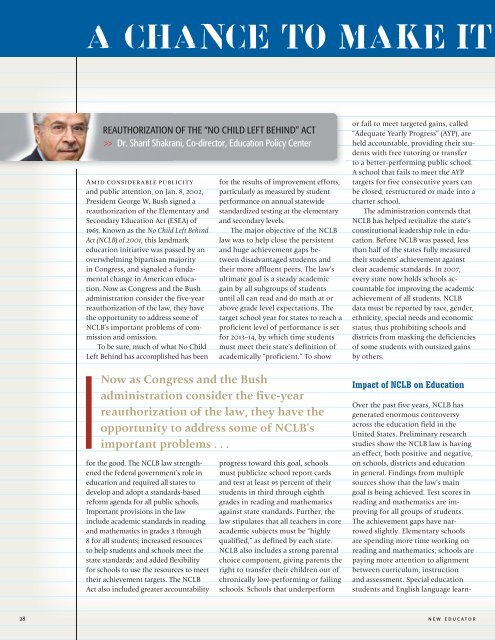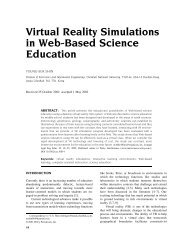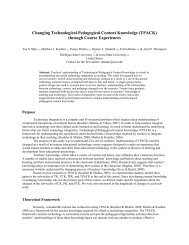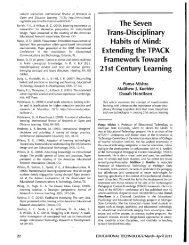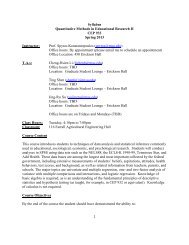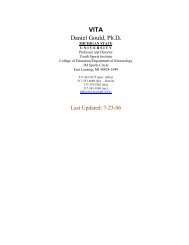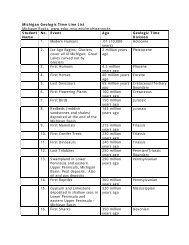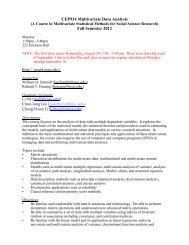Spring 2007 - College of Education - Michigan State University
Spring 2007 - College of Education - Michigan State University
Spring 2007 - College of Education - Michigan State University
Create successful ePaper yourself
Turn your PDF publications into a flip-book with our unique Google optimized e-Paper software.
a chance to make it<br />
REAUTHORIZATION OF THE “NO CHILD LEFT BEHIND” ACT<br />
>> Dr. Sharif Shakrani, Co-director, <strong>Education</strong> Policy Center<br />
Amid considerable publicity<br />
and public attention, on Jan. 8, 2002,<br />
President George W. Bush signed a<br />
reauthorization <strong>of</strong> the Elementary and<br />
Secondary <strong>Education</strong> Act (ESEA) <strong>of</strong><br />
1965. Known as the No Child Left Behind<br />
Act (NCLB) <strong>of</strong> 2001, this landmark<br />
education initiative was passed by an<br />
overwhelming bipartisan majority<br />
in Congress, and signaled a fundamental<br />
change in American education.<br />
Now as Congress and the Bush<br />
administration consider the five-year<br />
reauthorization <strong>of</strong> the law, they have<br />
the opportunity to address some <strong>of</strong><br />
NCLB’s important problems <strong>of</strong> commission<br />
and omission.<br />
To be sure, much <strong>of</strong> what No Child<br />
Left Behind has accomplished has been<br />
for the good. The NCLB law strengthened<br />
the federal government’s role in<br />
education and required all states to<br />
develop and adopt a standards-based<br />
reform agenda for all public schools.<br />
Important provisions in the law<br />
include academic standards in reading<br />
and mathematics in grades 3 through<br />
8 for all students; increased resources<br />
to help students and schools meet the<br />
state standards; and added flexibility<br />
for schools to use the resources to meet<br />
their achievement targets. The NCLB<br />
Act also included greater accountability<br />
for the results <strong>of</strong> improvement efforts,<br />
particularly as measured by student<br />
performance on annual statewide<br />
standardized testing at the elementary<br />
and secondary levels.<br />
The major objective <strong>of</strong> the NCLB<br />
law was to help close the persistent<br />
and huge achievement gaps between<br />
disadvantaged students and<br />
their more affluent peers. The law’s<br />
ultimate goal is a steady academic<br />
gain by all subgroups <strong>of</strong> students<br />
until all can read and do math at or<br />
above grade level expectations. The<br />
target school year for states to reach a<br />
pr<strong>of</strong>icient level <strong>of</strong> performance is set<br />
for 2013–14, by which time students<br />
must meet their state’s definition <strong>of</strong><br />
academically “pr<strong>of</strong>icient.” To show<br />
Now as Congress and the Bush<br />
administration consider the five-year<br />
reauthorization <strong>of</strong> the law, they have the<br />
opportunity to address some <strong>of</strong> NCLB’s<br />
important problems . . .<br />
progress toward this goal, schools<br />
must publicize school report cards<br />
and test at least 95 percent <strong>of</strong> their<br />
students in third through eighth<br />
grades in reading and mathematics<br />
against state standards. Further, the<br />
law stipulates that all teachers in core<br />
academic subjects must be “highly<br />
qualified,” as defined by each state.<br />
NCLB also includes a strong parental<br />
choice component, giving parents the<br />
right to transfer their children out <strong>of</strong><br />
chronically low-performing or failing<br />
schools. Schools that underperform<br />
or fail to meet targeted gains, called<br />
“Adequate Yearly Progress” (AYP), are<br />
held accountable, providing their students<br />
with free tutoring or transfer<br />
to a better-performing public school.<br />
A school that fails to meet the AYP<br />
targets for five consecutive years can<br />
be closed, restructured or made into a<br />
charter school.<br />
The administration contends that<br />
NCLB has helped revitalize the state’s<br />
constitutional leadership role in education.<br />
Before NCLB was passed, less<br />
than half <strong>of</strong> the states fully measured<br />
their students’ achievement against<br />
clear academic standards. In <strong>2007</strong>,<br />
every state now holds schools accountable<br />
for improving the academic<br />
achievement <strong>of</strong> all students. NCLB<br />
data must be reported by race, gender,<br />
ethnicity, special needs and economic<br />
status, thus prohibiting schools and<br />
districts from masking the deficiencies<br />
<strong>of</strong> some students with outsized gains<br />
by others.<br />
Impact <strong>of</strong> NCLB on <strong>Education</strong><br />
Over the past five years, NCLB has<br />
generated enormous controversy<br />
across the education field in the<br />
United <strong>State</strong>s. Preliminary research<br />
studies show the NCLB law is having<br />
an effect, both positive and negative,<br />
on schools, districts and education<br />
in general. Findings from multiple<br />
sources show that the law’s main<br />
goal is being achieved. Test scores in<br />
reading and mathematics are improving<br />
for all groups <strong>of</strong> students.<br />
The achievement gaps have narrowed<br />
slightly. Elementary schools<br />
are spending more time working on<br />
reading and mathematics; schools are<br />
paying more attention to alignment<br />
between curriculum, instruction<br />
and assessment. Special education<br />
students and English language learn-<br />
28<br />
new educator


